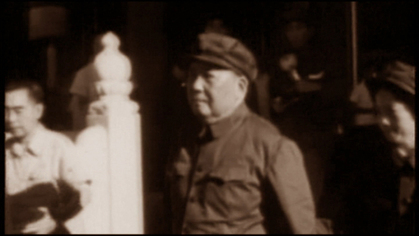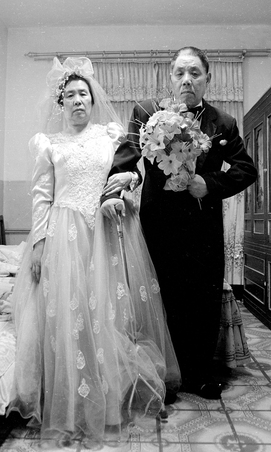-
From Current Issue
-
- Editor’s Letter Fire in the Heart
- Reviews I Gusti Ayu Kadek Murniasih
- Reviews 11th Seoul Mediacity Biennale: “One Escape at a Time”
- Dispatch Networked China
- One on One Monira Al Qadiri on Yukio Mishima
- Essays The rise of independent art spaces in pandemic-era Shanghai
- Features Tuan Andrew Nguyen
- Table of Contents
- Web Exclusives
- Archive
- Subscribe

R
E
V N
E
X
T
Installation view of WANG YOU SHEN’s Washing, 2017, news photographs, developing trays, water, clips, thread, dimensions variable. Courtesy August Haverkamp and Staatliche Museen zu Berlin.
The group show “Working on History” at Museum für Fotografie (Museum for Photography) in Berlin was an ambitious undertaking that examined 20th-century history, particularly that of China, through the photographic lens. With a stunning assemblage of 18 artists and helmed by renowned museum director Ludger Derenthal, CAFAM director Wang Huangshen and curator Guo Xiaoyan, the Herculean project of an exhibition managed to present a comprehensive picture of the Cultural Revolution (1966–1976), and captured recurring themes of collective memory and the importance of portraiture via a delicate treatment of archival material from the 1960s and ’70s.
Central to the exhibition was Wang Youshen’s Washing (2017) installation, an interactive workstation showcasing the process of developing—or over-developing—photographs. Arranged in the middle of the exhibition space, a number of tables offered an imitation of an open darkroom. Viewers were invited to agitate sheets of photo paper submerged in chemicals held in trays, contributing to the slow erasure of the photographic images. Wang’s Berlin version of Washing incorporated archival photographs from the Prussian Heritage Image Archive, opening up a dialogue between Chinese and German visual troves and the significance of constantly “reprocessing” both nations’ turbulent histories of the 20th century.
The Shanghai-born artist Maleonn presented a different take on developing photographs. Each of his achromatic images depicts a developing tray filled with curious photographic and organic objects collected from flea markets. In White on White #3 (2010), a family portrait taken at Tiananmen square is cushioned by small, white feathers, while White on White #4 (2010) shows a tray holding a male portrait covered with fish bones. Private records are interwoven with residual natural materials in the series, leading to the possibility that personal memorabilia can grow or decay long after the moment when an image was captured on film.
Next to the central tables, Zhang Kechun and Mo Yi revisited symbolic representations from the 1960s onward. Zhang’s People Crossing the Yellow River with a Photo of Mao Zedong, Henan (2012) references the legend surrounding Mao Zedong’s “world-record-breaking” swim in the Yellow River, and offers a humorous interpretation by recreating the myth in a setting with swimmers clinging to floatation devices, wading through water as they drag an enormous portrait of Mao, buoyed by a black inner tube, over the river. Set against Zhang’s amusing photographs on the opposite wall, Mo Yi’s evident take on red imagery in the Cultural Revolution—such as an image of workers leaning on a red wall in Red (1985)—were some of the most visually vivid works on display, and yet they fell flat when compared to other images that carried thicker messages.
Another corner of the show offered a different approach to contemplating forgotten or suppressed narratives. While He Chongyue and Zhuang Hui both use large group portraits to illustrate the severe ideological and generational shift from collective to individual portraiture, Wang Ningde conveys the emotional statis of former young pioneers and soldiers through dream-like depictions. In his staged, black-and-white “Some Days” series (1999–2009), anonymous men dressed in uniform wander desolate landscapes, gazing into the distance as if hypnotized by visions of a lost utopia. However, their muted yearning for the unknown was defied by the neighboring portrait diptych They (2000) by photographer Hai Bo, calling forth a far harsher reality by juxtaposing group portraits from the 1970s and their contemporary revivals with the same groups. Aged faces and empty chairs reveal the trauma of the subjects’ collective experiences, and viewers are left to wonder about the intricacies of the circumstances that welded their fates together 50 years ago.
A disturbing answer to this question is given by video artist Cao Kai’s wall projection Summer of 1969 (2001–02). Named after the 1985 Bryan Adams song Summer of ’69 that accompanies the video, Cao’s snippets from various archives across the globe take a trip down memory lane to revisit 1969, a year permeated by mass movements not only within China, but around the world. Stirred by Adams’s anthem but alarmed by the film sequences’ blind enthusiasm, viewers are made painfully aware of their own compliance mechanisms triggered by pop culture.
Besides prominent works by renowned artists such as Feng Mengbo’s interactive installation My Private Album(1996) that explores the artist’s lineage and family history, Wang Qingsong’s three-meter-wide photograph Competition (2004) of a 40-by-14-meter wall covered by 600 sheets of paper on which advertisement slogans are scribbled, and Song Yongping’s intimate portrayal of his aging parents in New Life (1999), the exhibition also attracted attention to a notable amount of archival photographs from the 1960s to the late 1970s, drawn from personal collections of former photojournalist Weng Naiqiang, and artists Cai Dongdong and Zhang Dali. The latter’s thorough research on Mao Zedong’s visual narrative and manipulation of images, in a work titled A Second History (2005), could also be found in the back of the show.
Elsewhere, photographer Qu Yan, as well as the artist couple Shao Yinong and Mu Chen, turned their lenses toward the architecture of China. Qu depicts various villages’ Communist Party offices, where political imagery shares space with everyday utensils, such as thermos bottles or television sets. Shao and Mu’s long-term “Assembly Hall Series” (2002– ) captures former assembly halls across China as sites of collective memory, echoing the nation’s—or the Party’s dictated—communal spirit off their brick walls.
With an overwhelming range of works and historical documents confined to a single exhibition hall, the show provided exactly what its title promised: the artists involved were “working on history” through visual narratives and new forms of participation, trumpeting the importance of revisiting historical narratives in both German and Chinese culture today.
“Working on History: Contemporary Chinese Photography and the Cultural Revolution” is on view at Museum für Fotografie, Berlin, until January 7, 2018.
To read more of ArtAsiaPacific’s articles, visit our Digital Library.












